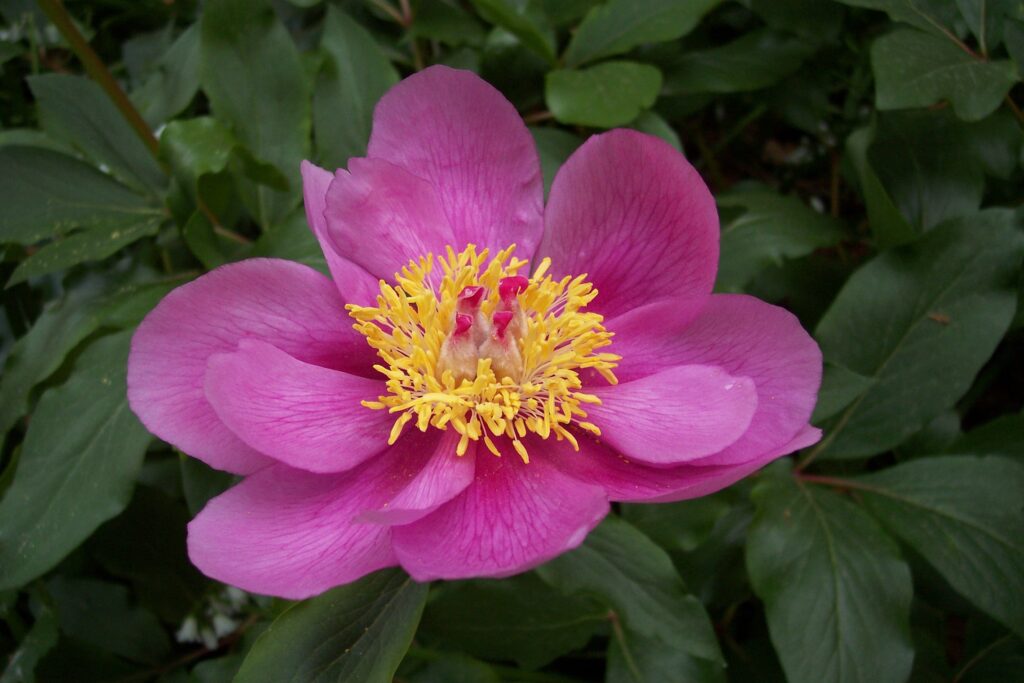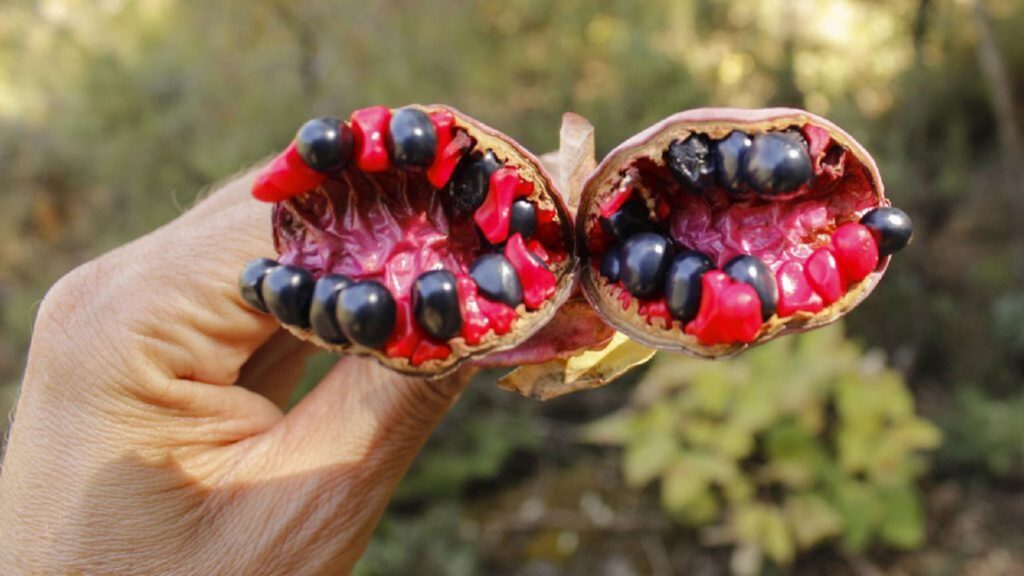The Rose of Alexandria is a plant native to the Iberian Peninsula, it is distributed between the mountains of Portugal and Spain, this species was identified as Paeonia budori, popularly known by many names such as: Rosa de Alejandría, Peony, Rosa de Santa Clara, Rosa Silvestre and many other names. It is a very pretty plant. I invite you to learn more about her.

Rose of Alexandria or Peony
Rosa de Alejandría, Peony, Rosa de montés, or Rosa de Santa Clara, are just some common names with which people know the species. Paeonia budori, plant of the botanical family Paeoniaceae. It is a herbaceous plant about 70 centimeters high, which is distributed between 100 and 1850 meters above sea level, in the mountainous system of the Iberian Peninsula, which encompasses the countries of Spain and Portugal.
Description
It stands out for having spectacular red flowers; its leaves are simple, sometimes divided or ovate or oval-lanceolate, bright green and smooth or glabrous on the underside, with sessile petioles and acute apex; its stem is glabrous, about 50 centimeters long, and red leaves grow at its base; the plant as a whole reaches about 70 centimeters high. Its flowers are hermaphrodite, this means that the male and female reproductive organs are found in the same flower.
Habitat and distribution
It is a plant that grows in soils rich in calcium or magnesium and calcium carbonates in forests or ombrophilous jungles, that is, with a lot of shade. In the mountainous and rocky regions of the mountainous system of the Iberian Peninsula. It is born among the mountain thickets, in the lower level or undergrowth of the Oak Forest, as well as in the gall oaks, coniferous forests such as the oak, accompanying the cork oak trees and riverside forests.
Rosa de Alejandría is an indicator plant of the province of Carpetano-Ibérico-Leonesa, it can be found growing in association with Luzula forsteri-Quercus pyrenaica (Guadarrámicos melojares) and Juniperus oxycedrus-Quercus rotundifolia. Between 100 and 1850 meters high, from the edge of the coastal zone to mountainous regions. From the mountainous system of central and southern Spain and Portugal, in sectors with siliceous soils, in the undergrowth of holm oak forests, improvement fields and where oak and cork oak trees are dominant.
Taxonomic Characteristics
The botanical species paeonia sproutori, was identified by Boiss. & Reut. Publishing your report in the botanical journal Diagnoses Plantarum Novarum Hispanicarum, N° 4, of the year 1842. In the Cytological analyzes the number of chromosomes of the species was determined Paeonia budori of the family Paeoniaceae and other infraspecific taxa, from: 2n=104.
The origin of the genus name Paeonia, is a Latin word paeǒnĭa, ae, this generic name was placed in homage to Pawn, who is a character in the novels written by Homer, "The Iliad" and "The Odyssey". According to the novels, this Pawn doctor cured Ares when Diomedes wounded him when he participated in the Trojan War; he was also the physician who healed Hades from an arrow that struck him and was launched by Heracles at Pylos.
It was named as a medicinal plant by Pliny the Elder, in books 25, X, 1, to calm those who suffered from "nightmares caused by the Fauns". his epithet buddy, they placed it in honor of the botanist of the time of Linnaeus, named Félix de Avelar Brotero.
Other names or Synonyms of the species:
- Paeonia bromari var.. ovatifolia Boiss. & Reut.
- Paeonia coralline there. buddy (Boiss. & Reut.) Coss.
- Paeonia coralline f. buddy (Boiss. & Reut.) Voss
- Paeonia coralline f. ovatifolia (Boiss. & Reut.) Rouy & Foucaud
- Paeonia lobata Def. former DC. nom. illeg.
- paeonia lusitanica (mill)
- paeonia lusitanica there. ovatifolia (Boiss. & Reut.) Samp.
- Paeonia mascula there. buddy (Boiss. & Reut.) Gürke
- Paeonia mascula there. lusitanica (Mill.) Samp.
- Paeonia mascula there. ovatifolia (Boiss. & Reut.)
- Paeonia mascula f. ovatifolia (Boiss. & Reut.) Cout.
- Paeonia officinalis var lusitanica (Mill.) Martin
Common Names
When botanist taxonomists give plants scientific names, they do so by carrying out a study of botanical keys and observations of the morphology of the different parts of the plant that allows them to identify which botanical family it belongs to, the genus that groups it and identical according to some distinctive characteristic of the plant, which are also observed in others of the same family and finally the species is identified, by a unique aspect that distinguishes it from other plants.
All this allows us to really know what plant it is because the same plant can receive many vulgar, common or everyday names, depending on how people know it or in the language used in the locality. Below are some common names for this plant: Rose of Alexandria, Peony, Santa Clara rose, Santa Maria rose, lizard rose, wolf rose, mountain rose, realgar rose, scabies rose, devil rose , mountain rose, male and female rose, cursed rose, withered rose, mojosa rose, montesa rose, montesina rose, montesina rose, and many other names.
Management and Care
First of all, if you like to grow plants, it is suggested that you buy them in nurseries because you can find specimens that have already acclimatized to the place where you live and this will facilitate their care and guarantee the survival of the plant. In this way, it contributes to the conservation of plants such as the Rose of Alexandria in nature and the forests where it lives. Yes, you have already acquired a specimen or several in a nursery, I suggest the following care:
where to locate it
As you may have already read, the Rose of Alexandria Peony plants develop and grow in ombrophilous forests, that is, with a lot of shade, which are found from coastal areas to mountainous areas. In soils with silica and calcium or magnesium, with moisture and good drainage. These factors can guide you to select where to locate the plant.
suitable substrate
This indicates that you have to select a place in the garden with a lot of shade, this can be in a clearing in the garden where there are some tall trees that create shade with their foliage. This is a good place to plant your Rose of Alexandria specimen(s). It has to acquire a substrate with a pH greater than 7, since it grows in soils with a basic pH due to the presence of calcium or magnesium salts. Add in the hole where the Rose of Alexandria was planted.
Whether you are going to have it in a pot or in the garden directly, you have to prepare the substrate to guarantee its good growth. In the pot: you can mix the fertilized soil with a substrate that meets the characteristics of pH and content of calcium salts. In proportion 70% fertilized land and 30% substrate.
Irrigation frequency
The frequency of irrigation will depend on the season of the year, during the summer it is suggested to water between 3 to 4 times a week. Decrease the frequency of watering, during the fall and winter seasons first check the soil to see if it is dry and then water without flooding the soil to prevent the roots from freezing. Especially depending on the height above sea level that your house is located and the temperature differences.
Manure or fertilization
It is suggested to apply compost or organic fertilizer to your Rose of Alexandria specimen, between the months of the hottest seasons during the year, that is, between spring and summer. It is suggested to use guano or another organic fertilizer, to avoid having many agrochemicals at home, especially if there are children. If you have chemical fertilizer, please identify and place it in a place out of reach of children.
Transplant and definitive planting
It is suggested to transplant once, after the winter and the risks of frost have passed, on the other hand, if you have it in a pot inside the house, it is suggested to change to a larger pot every two years.
Propagation of the Rose of Alexandria
You can propagate the Rose of Alexandria plant by its seeds, once its fruits have ripened you can obtain its seeds, for this I suggest you follow these steps:
- Once you have chosen the Rose of Alexandria seeds, wash them and place them in a bag with a little copper or sulfur to prevent the appearance of fungi. The next day you choose a slightly deep tray, about 5 centimeters. On this tray you place a moistened napkin and then place the seeds to germinate. To avoid the presence of insects and keep the napkin moist, cover the tray with transparent plastic. This way you can see if the napkin dries out and how the seed germination process is going.
- Once the seeds have germinated (their roots and three first leaves have been emitted), the seeds are transferred to a medium-sized pot, the substrate of the pot is suggested to be vermiculite, which you have to water to keep it moist, but not flooded.
- Leave the Rose of Alexandria planted in this pot, so that it develops and strengthens its roots and the whole plant, it can be transferred to a pot or to the garden in about six months, depending on the case.
Its utility
Due to the beauty of the plant and flowers, it is used to grow in gardens where there are shaded trees and planters. It is used as a separator of areas within the garden due to its height of 70 centimeters. They also use it as an ornamental plant inside the house, placing it to dry from windows or on terraces where indirect sunlight and breeze arrive.
Conservation of the Rose of Alexandria
It is an endemic plant of the Iberian Peninsula, and is under a protection regime. Its flowering is short-lived, for this reason the specimens in nature must be respected so as not to threaten their propagation in their natural environments.
You will be able to observe in their natural environment, the populations of Rosa de Alejandría in the Tentudía region, they are decreasing in the mountains of Extremadura. If you travel to the Tentudía region, you can see them around the Cuevas de Fuentes de León, the Sierra de Tentudía or the Paraje de los Cortinales in Cabeza la Vaca and surrounding areas.
I also invite you to read the following posts:


